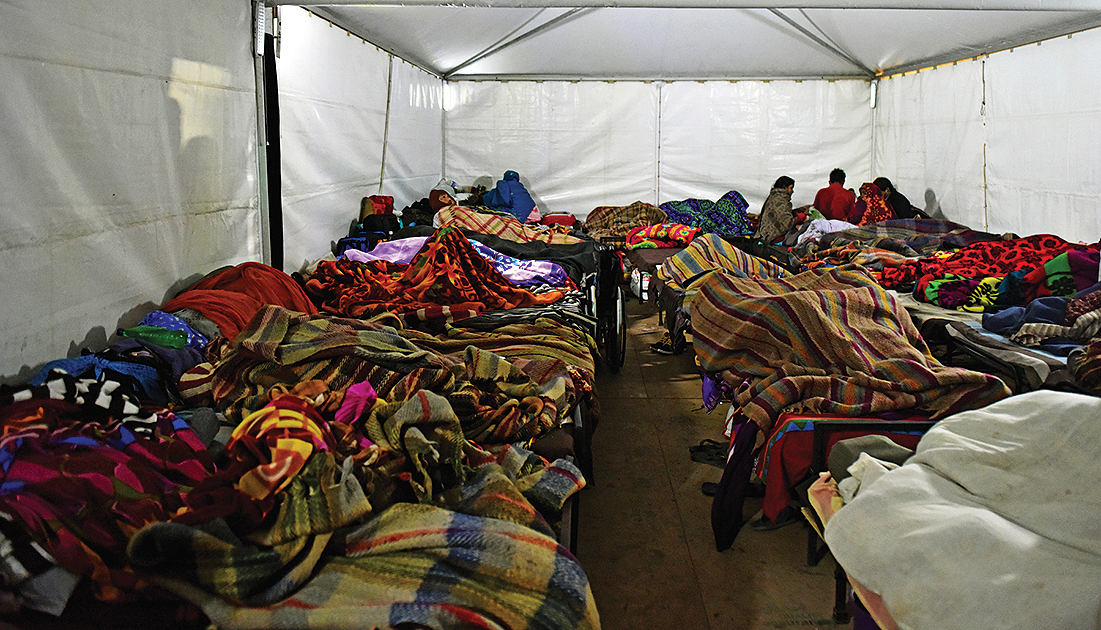
It’s the part of Delhi we often ignore. The part that stays outside the gated colonies, doesn’t go to malls. The part of Delhi that is hidden. Ugly, yet still significant. This Delhi doesn’t have a roof over it’s head, and braves teh biting cold and pollution in the open.
Arvind Kejriwal’s government made special arrangements this year and many porta cabins, tents and some buildings have been earmarked in 204 locations in Delhi with a capacity to hold some 17,000 homeless people. On an average, a porta cabin can hold 50 people, though the one located at Yamuna Pushta has a capacity of 200 people. Tents too can accommodate 50, all cramped up inside like bundles stashed in a lorry.
There are many estimates of the number of people residing on the streets of Delhi, civil society putting the figure at around 1,50,000-2,00,000.
Occupancy falls by 75 per cent during the day, as many of the homeless venture out to earn their living.
Delhi Urban Shelter Improvement Board (DUSIB) has made elaborate arrangements from November to March, purchasing 20,000 blankets and 5,000 sets of mattresses and durries, informs Bipin Rai, member-expert of the DUSIB. In addition, NGOs working for the homeless have organised an additional 15,000 blankets. These efforts, though commendable, are grossly inadequate.
Ritesh Kumar, 23 years, is a graduate. He has been living near ISBT in Sarai Kale Khan for nearly two weeks. There’s a porta cabin for the homeless in which he slept one night, but it’s difficult to find space there. He is mostly awake during the night, walking around to keep himself warm. Lately, he sleeps inside the bus station, or on the roof of a bus – inside the bus if drivers allow him on condition that he cleans it up. His clothes are soiled, and he lost his bag one night. An old Nokia mobile is his treasured possession and he insists, “I’m not a beggar.”
Ritesh belongs to a poor family of landless farmers from the district of Bursaria in Bihar. He was supposed to stay with a friend from his village who promised to find a job for him. Ritesh went to the given address in Okhla but he was not to be found there. Within a week, he had spent the small sum of Rs 1,000 he had travelled with, and started living in Sarai Kale Khan because his friend, to the best of his knowledge, is a ticket collector in a private bus that shuffles between Hapur and Delhi.
Ritesh has lost hope of finding his friend but has met a few others who have promised him the job of a labourer at a construction site in Naraina from January 1. “Going back is not an option. There’s no food at home. Here there’s no home,” he says, refusing our offer of monetary help.
A migrant labour from Azamgarh, Ramu, who lives with his five children near the Nehru Place flyover, prefers a road divider to sleep on than a night shelter tent. “The night shelter is not safe for women and children. You are safe if you sleep out in the open,” he shares his survival tactics.
There are many families residing in and around the Nehru Place flyover with women and children. As per one estimate, one fifth of all homeless people are women. They move around as a unit beg and cook along the pavement or in the back alley during the day, and at night sleep in the night shelter tents, or outside.
One of them is Rajni, who looks like a teenager, slender frame, sharp features on a conical face, her piercing eyes are pale in colour. Already a mother of two, she is at first not interested in a dialogue.
Finally relenting, she informs that she’s from Barmer in Rajasthan, makes Rs 200 a day, part of it has to be given to the head of the family, rest she spends on feeding her children. Her alcoholic husband died a few months ago due to high fever and she now lives with her husband’s elder brother. She seems to admire the city: “Delhi never lets anyone die of hunger,” she says prophetically and insists she’s not part of any organised beggar gang. “I came here on my own to feed my children,” she says with a straight face.
Lately, in the name of beautification, homeless people residing under the flyovers or along the streets have been driven away with their possessions–rolled up bedding, utensils, stoves, carts, plastic sheets and such things. Now there are gardens, and at few locations art installations. These beautification drives have started at seven flyovers, Nehru Place being one of them, under corporate social responsibility (CSR) programmes. The arrangement is that in return for upkeep of the crossings, the companies are allowed 150 sq ft of space for advertisements.
But the poor and homeless just can’t be wished away. Many like Rajni and Ramu still reside in the area, some sleep in the night shelter, others in the parking area, on road dividers, in the back lane, inside a pit, two or three huddled together under a dirty blanket wet with dew. As they say, life goes on.
At 8.30 am, Delhi's Air Quality Index (AQI) stood at 402, in the 'severe' category,…
In 2023, thousands of anti-encroachment drives were held across Delhi, accounting for 52% of the…
From the Kashmir valley to the global stage, the santoor maestro weaves a 300 year…
Under the Sanjeevani Yojana, the Delhi government will provide free treatment to people aged above…
The Air Quality Index (AQI) deteriorated from 370 on Saturday to 393, placing it in…
From St. Stephen’s to St. James, a look at the vibrant history, architecture, and communities…